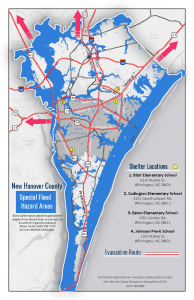There is not a county-wide evacuation order in effect.
In the event of an emergency, New Hanover County may order residents to evacuate from dangerous areas and may choose to open shelters. The type of emergency and area affected will determine evacuation areas, as well as where and how many shelters will be opened.
When creating your emergency preparedness plan, include plans for both evacuating and staying put, also referred to as “sheltering in place.” Read more about preparing for each of these scenarios in the panels below. More information is also available at ReadyNC.org.







